The relationship between pharma companies and advocacy groups is important for all stakeholders but more needs to be done to create truly interactive, transparent relationships.
The most effective approach for pharma companies to truly be patient-minded is a combination of engaging with patients and caregivers while building trusting, sustained relationships with the advocacy groups that serve the patient communities, says Jenny Sparano, director of patient strategy, Eversana Engage.
But just how symbiotic is the relationship between pharma and patient advocacy groups? Not as broad or extensive as it could be.
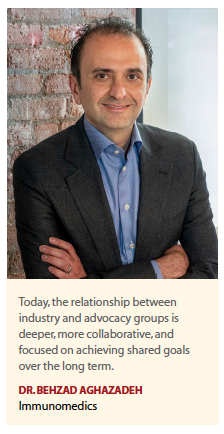 According to Michael Keens, chief operating officer at Firma Clinical, while many pharmaceutical companies do work with advocacy groups aligned to the diseases they’re researching, the relationships are quite narrow and are usually focused on very tactical approaches.
According to Michael Keens, chief operating officer at Firma Clinical, while many pharmaceutical companies do work with advocacy groups aligned to the diseases they’re researching, the relationships are quite narrow and are usually focused on very tactical approaches.
“For instance, many patient advocacy roles within pharma provide financial sponsorship support for advocacy regional meetings, national/local events, and in collaboration with patient advisory boards," Mr. Keens says. “While these interactions are worthwhile, such approaches are limited in the scalability and benefit for the groups involved."
Ms. Sparano says beyond sponsoring advocacy events and scholarships that make it possible for patients to attend conferences, pharma can host advocacy working groups on a regular basis.
“These in-person meetings bring advocacy leaders and pharma to the same table with the goal of identifying unmet needs of the patient community, establishing common objectives, building trust, and pinpointing opportunities to collaborate," she says. “Having a patient and/or caregiver present at these sessions is ideal to ensure the focus remains on the underlying thread that unites them ––doing what’s right for the patient."
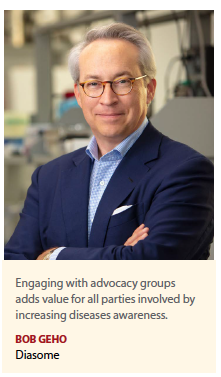 Experts say much more could be done to improve the care experiences for patients by creating a more interactive, transparent relationship between the industry and advocacy groups.
Experts say much more could be done to improve the care experiences for patients by creating a more interactive, transparent relationship between the industry and advocacy groups.
“Patients benefit when pharma and advocacy collaborate from a foundation of shared goals," Ms. Sparano says. “Relationships and synergies can be built with the net result being improved education for patients, awareness of clinical trials and treatment options, and enhancements to the overall patient experience. Whether the advocacy space is crowded or there are one or two mainstays, which is common in a rare disease community, the approach is the same in terms of initiating a dialogue, bringing the key players together to collaborate, setting goals and actionable steps to achieve them, and committing to on-going collaboration to get the work done."
Amy Graham, client engagement officer at Ogilvy Health, says there needs to be transparency from the start, establishing a clear understanding of expectations and deliverables of what each party anticipates from the relationship.
Ric Cavieres, president of Oz, says pharma companies needs to redefine their patient strategies to include patients’ missions, how they measure impact, which advocacy groups they should engage with, which functions should engage with these groups, what programs will most effectively drive two-way engagement, and which communication media and platforms are most effective.
Kelli Belsinger, account director at Dudnyk agrees, saying the agency’s pharma clients have been most successful when they approach advocacy groups with complete openness and transparency, and with a willingness to listen and understand the needs of the rare populations they serve.
In a 2019 Accenture survey, Keena Patel, managing director of the life sciences practice, asks: “What if pharma shifted its view of patient organizations from a policy and advocacy standpoint to what they could collectively do to improve patient care?"
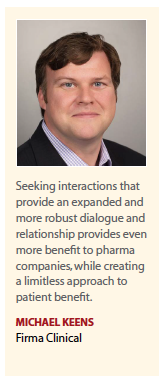 Mr. Keens says some ways companies could expand the relationship with advocacy groups include providing contacts within R&D as well as commercial operations to help communicate potential areas of collaboration and relationship expansion, setting aside time to review developmental pipelines and upcoming trials where advocacy groups may be able to contribute their thoughts or perspectives, and truly understanding how to help improve the mission of the advocacy group. “Advocacy groups often say their interaction with pharma often comes only when something is needed, for example registry data, patient contacts, etc., and often without regard for the goals or needs of the advocacy group," he says.
Mr. Keens says some ways companies could expand the relationship with advocacy groups include providing contacts within R&D as well as commercial operations to help communicate potential areas of collaboration and relationship expansion, setting aside time to review developmental pipelines and upcoming trials where advocacy groups may be able to contribute their thoughts or perspectives, and truly understanding how to help improve the mission of the advocacy group. “Advocacy groups often say their interaction with pharma often comes only when something is needed, for example registry data, patient contacts, etc., and often without regard for the goals or needs of the advocacy group," he says.
Support for Partnership
The Accenture survey found that 84% of patient respondents want pharma and advocacy groups to work together, while 64% of patients said they’d be willing to share more information with these groups if it would improve their healthcare experiences.
According to a survey of 3,000 patients and caregivers carried out by Rare Patient Voice, while a majority were in favor of advocacy groups partnering with industry, 10% were opposed and a third weren’t sure.
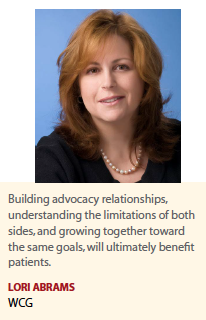 “Some who are opposed are nervous about advocacy groups being too closely aligned with pharma and losing their independence," says Wes Michael, president and founder of Rare Patient Voice. “For example, one MS patient was opposed to partnerships, stating that ‘big pharma is out to make money … period!’"
“Some who are opposed are nervous about advocacy groups being too closely aligned with pharma and losing their independence," says Wes Michael, president and founder of Rare Patient Voice. “For example, one MS patient was opposed to partnerships, stating that ‘big pharma is out to make money … period!’"
However, Mr. Michael says the main message was that it’s important for both parties to understand each other, and there is recognition by many that when scientists work with those living with a disease, it adds a human element and serves to highly motivate those smart enough to effect a cure.
Cheryl Lubbert, president and CEO of Health Perspectives Group, says it’s important that partnerships are built carefully to avoid compromising the integrity of patient advocacy groups.
“With the rise of patient influencers across social media, the lines are blurrier than ever when it comes to unbiased support channels that patients can turn to," Ms. Lubbert says. “Advocacy groups can and must continue to play that role and serve patients, absent of any conflicting interests."
She says pharma and advocacy groups must identify shared objectives they can both work toward supporting, without intermingling their resources in a way that’s problematic.
 Mr. Cavieres says patients trust advocacy groups because they perceive that they do not have an agenda.
Mr. Cavieres says patients trust advocacy groups because they perceive that they do not have an agenda.
“Empowering these groups — and thus the patients — with up-to-the-minute information on new and existing rare disease treatments is literally life-changing and, in some cases, life-saving," he says.
Engaging with advocacy groups adds value for all parties involved by increasing awareness, says Bob Geho, CEO at Diasome.
“Advocacy groups and patients can benefit especially by remaining up to date on the latest medical innovations, while pharmaceutical companies can benefit by listening to patients to better understand how they manage their disease — first-hand insights that only patients can provide," he says.
Laura Wilson, patient strategy in Fingerpaint’s Cedar Knolls, N.J., office, says advocacy groups recognize that working with pharma 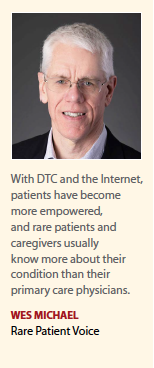 companies can lead to life-altering outcomes, such as a therapy being approved faster, but it can also create false hope. “It’s a tough balance for advocacy groups, especially ones that monetarily support research projects," she says.
companies can lead to life-altering outcomes, such as a therapy being approved faster, but it can also create false hope. “It’s a tough balance for advocacy groups, especially ones that monetarily support research projects," she says.
The advocacy-pharma relationship can play a critical role in designing and accelerating drug development for the treatment of rare diseases, which can be extremely difficult due to the small population of patients with a given rare disease, Ms. Graham says.
“This establishes a paradigm where the partnership creates experiences that are more focused on meeting the needs of patients," she says.
Patients with rare, hereditary diseases often seek information not only on the disease, but also other psychosocial aspects, such as how to have conversations with family members who could also be affected, Ms. Belsinger says.
“Pharmaceutical companies are in a position to offer up-to-date, robust information on a number of topics relevant to a patient with a rare disease, including treatment options that could offer hope not only to them, but to family members," she says.
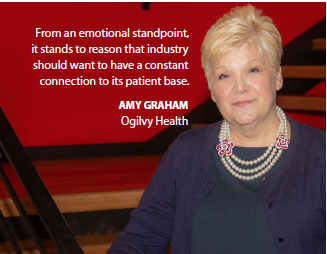 Dr. Behzad Aghazadeh, executive chairman at Immunomedics, says the challenge of navigating the rare disease landscape is real, and the voices of other patients with experience can be hard to connect with or even find.
Dr. Behzad Aghazadeh, executive chairman at Immunomedics, says the challenge of navigating the rare disease landscape is real, and the voices of other patients with experience can be hard to connect with or even find.
“A strong partnership between pharma/ biotech and advocacy groups can help identify the critical information gaps from diagnosis of disease onward," he says. “The tighter the partnership and information-sharing between critical stakeholders, the more frictionless the effort to bring new therapies to market and to ensure that patients, their caregivers, and society at-large benefit from medical advances, while giving voice and dignity to each patient."
While building a trusted relationship ultimately is to benefit patients, it also is vital for the sponsor company, which can learn a lot from advocacy groups early in the discovery phase, or when a potential treatment is pulled from the shelf, says Lori Abrams, senior director, advocacy, at WCG.
While pharma-advocacy relationships have increased during the past decade, many groups are still struggling with making the first move, looking for the type of partnership that would suit them, and in some cases, understanding the differences between R&D advocacy and commercial advocacy in pharma, Ms. Abrams says.
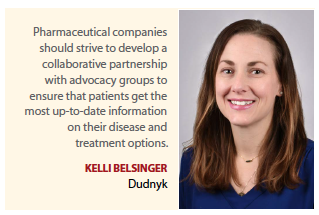 She adds that bringing in the voice of the patient is essential for developing and operationalizing a clinical trial that leads to a better patient experience.
She adds that bringing in the voice of the patient is essential for developing and operationalizing a clinical trial that leads to a better patient experience.
In the area of rare disease in particular, advocacy groups can help companies with clinical trial recruitment, focus groups, and in some cases, funding for research, as well as insight into the struggles the patients have.
Ms. Wilson says it’s important to ask some critical questions: what does the patient value?; how is the disease impacting their quality of life?; what do they need that they are not already getting?; how practical is the therapy?
One of the advantages of a well-rounded pharma-advocacy relationship, especially in the rare disease field, is the ability to provide more information and knowledge to patients, who, because of their need to quickly become familiar with their diagnosis, have some of the highest rates of engagement with advocacy groups and research, Mr. Keens says.
Kinnari Patel, Pharm.D., chief operating officer and executive VP, Rocket Pharmaceuticals, says by working with advocacy groups, the company can further strengthen educational resources, with its unique knowledge gained as a company that specializes in a number of rare diseases.
“This relationship truly benefits us by allowing us to hear patient voices and use patient feedback to inform our drug development moving forward," she says.
Formalizing the Interaction
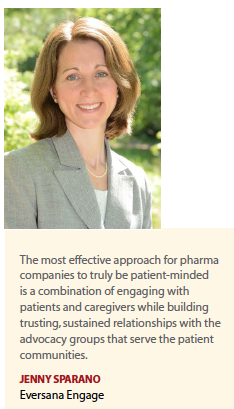 While there’s no magic formula for how often pharma companies should interact with patient advocacy groups, Ms. Graham says there should be an advocacy pillar in the annual brand planning process that addresses how the interaction can enhance the patient experience, and how the advocacy relationship can develop and grow throughout the lifecycle of the drug.
While there’s no magic formula for how often pharma companies should interact with patient advocacy groups, Ms. Graham says there should be an advocacy pillar in the annual brand planning process that addresses how the interaction can enhance the patient experience, and how the advocacy relationship can develop and grow throughout the lifecycle of the drug.
The relationship between a sponsor and advocacy group should begin once the pipeline for the upcoming year is known, Ms. Abrams says.
“Methods of building a trusted bond between a company and advocacy group might include: inclusion in advisory boards; playing an active role in the development of campaigns; co-authoring written materials; and clinical operations volunteering to do logistics work at family conferences," Ms. Abrams concludes.
Mr. Geho says pharmaceutical companies can be more interactive with advocacy groups by helping to promote their work via social media.
“Another technique we have found successful is engaging with bloggers and influencers in the diabetes community, who often have advocacy group connections," he says. “We have successfully collected and shared input from advocacy group leaders through posting invited blog entries on Diasome’s website. By engaging in blogging we have been able to raise disease awareness and maintain a conversation about various perspectives on living with Type 1 diabetes."
Ongoing, regular communication helps to establish trust, Ms. Belsinger says.
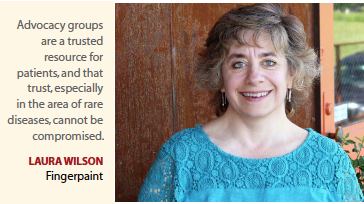 “One of our clients recently partnered with a few leading patient advocacy groups in the rare disease space to sponsor a live online patient educational series hosted by a third party," she says.
“One of our clients recently partnered with a few leading patient advocacy groups in the rare disease space to sponsor a live online patient educational series hosted by a third party," she says.
“Because of the established relationship that our client’s advocacy group had with the patient advocacy groups, they were able to create a successful program that brought together doctors, advocates, and patients living with the disease to illuminate a variety of important topics."
Dr. Aghazadeh says dedicated patient experience leaders at pharma/biotech companies should routinely engage with patient advocacy groups to listen and learn, partner on solutions and services for patients and their caregivers, and share relevant corporate updates and developments.
“The frequency of contact is determined by and tailored to each relationship, but these collaborations often deliver innovative outcomes at various conferences, gatherings, and online forums throughout the course of a given year," he says.(PV)
~~~~~~~~~~~~~~~~~~~~~~~~~
Patients’ Voices
 Melissa Adams VanHouten
Melissa Adams VanHouten
AGMD Public Policy & Outreach Director
Gastroparesis
@MelissaRVH
It is sometimes difficult for patients and patient advocates to find opportunities to interact directly with pharma. A greater presence and increased engagement with patients on social media platforms such as Facebook, Twitter, and Instagram might help increase the knowledge of these opportunities as well as trust among the groups. And, again, reaching out directly to patient advocates — bringing the opportunities directly to us rather than forcing us to seek them out — would likely increase engagement and strengthen relationships. As far as value, quality interactions would serve to better inform pharma of patient needs/wants and would also better inform patients of pharma’s efforts to collaborate with patients and develop useful therapies.
As the creator and administrator of several online support and advocacy groups, the Public Policy and Outreach Director for the Association of Gastrointestinal Motility Disorders (AGMD), and a volunteer for other disease-related organizations, I interact daily with both patients and companies/organizations. It is my goal to act as a voice for those who sometimes feel voiceless and powerless.
Brittany Anderson
Advocate
Fibrous Dysplasia / Rare Diseases
@Brittan18284278
I think social media is a huge platform to engage with advocacy groups. I myself am involved in many groups and they are all on social media. To do so would benefit us all. To us patients, social media allows us to work together and see and learn at the same time. It would allow us to share our story and experiences to help ourselves and our fellow patients. It would help pharma by having input only collected by those who are experiencing what they are studying, no one from the outside looking in. It would help our groups because research is key to any disease or condition and spreading information gives us hope and helps motivate others to advocate and fight to share their story as well.
 Lauren Freedman
Lauren Freedman
Invisible and Chronic Illness
@uninvisiblepod
Patient advocacy groups are often a patient’s first port of call in a sea of resources. With diagnosis, there is often a period of adjustment and misunderstanding — a time of confusion and fear, when the patient feels overwhelmed and doesn’t know where to turn for information and support. Advocacy groups create community and provide vital resources to patients. Some become who they were meant to be simply because of the connection to this community.
 Daniel Garza
Daniel Garza
Patient Advocate
There are some regulations in place that limit how much interaction there is between a pharmaceutical company and clients. But I think this needs to change. How else can we do our jobs as advocates if we can’t provide our point of view to the companies?
As advocates we are, for lack of better words, the voice of a group. We see what’s happening in our community and we can offer that feedback to a company. What is working, what is not, what will help heal or better a person’s life. It’s a two-way street. We help the pharmaceutical company serve the community better and help the community be better informed and educated. This also helps the health service community. We come into an office prepared and an active participant in our care.
Annie-Danielle Grenier
Rare Diseases, Ehlers-Danlos Syndromes and Adrenal Insufficiency
@ADanGrenier
Collaboration is always a step in the right direction, but when it comes to rare diseases, we can’t live without it. There are more than 7,000 rare diseases. How could the industry know about them all, even -more so, how could they know the specific needs of the rare diseases patients? There needs to be a discussion for something to happen, and definitely something needs to happen.
Karen Hoyt
Patient Advocate
Liver Disease, Hepatitis
@hepatitisihelpc
Pharma can be interactive through patient experiences in written content and storytelling, in forums where a patient is moderating, and with one-on-one counseling when necessary, for example, when preparing for or during treatment. This provides value by creating a personal relationship or connection between people who share common concerns. I think that with fewer layers between pharma and the patient, more trust is developed by the masses. So, a patient doesn’t advertise on their personal site, but works with a site that is known to recommend and advertise for pharma.
 Lynn Julian
Lynn Julian
Patient Advocate
Lyme Disease, Ehlers Danlos Syndrome, Brain Injury, Arthritis
@popsuperhero
I interact with patient advocacy groups daily as a proud patient advocate. I am the Massachusetts ambassador for the U.S. Pain Foundation; NORD; Rare Action; EhlersDanlossociety; LymeDisease.org; and more. I lead a support group for the Boston chapter of the largest Marfan’s/EDS/connective tissue disorder support group in the United States, with more than 2000 members.
Soojin Jun, Pharm.D.
Pharmacist
Advocate Aurora Health
The profit-driven nature of healthcare in the United States makes it difficult for patients to trust the sincerity of pharma’s engagement efforts. In order for pharma to be more interactive with patient advocacy group, putting investment in building the trust is the foremost need. Often the word engagement is used to find what pharma wants to get from patients. This type of mindset will turn patients away. Patients are tired already, with bills, appointments, and even keeping up with work, to be able to afford insurance and get the right care.
Many patient advocates get asked to work either for free or with bare minimum conference reimbursements. If their voices are valued, then patients and advocacy groups should be compensated accordingly. As a caregiver turned pharmacist, I attend conferences as an advocate mostly, not as a pharmacist. I would speak for patients with language and cultural barriers as those were contributing factors to the medical harm my dad experienced and died. Many times pharma only listens to outspoken advocates and patients and this creates a big gap in understanding the unspoken, minority patients with language barriers. There is little diversity in conferences and leadership, so it is natural that this type of topic does not get discussed. Not only does this create bias, but more importantly, pharma misses out on what is important in this population. The United States is a microcosm of the world’s population. If pharma can study this population well, it is like it has studied the world in a way.
 Kristal Kent
Kristal Kent
Patient Advocate
Fibromyalgia, Chronic Pain And Military Veteran’s Medical Needs
As an advocate and patient leader, building relationships is the key to building trust among patients. Oftentimes, patients go through a series of doctors, testing, and treatments, which causes frustration and lack of trust of the pharma and healthcare system. By cultivating a positive, supportive relationship with patients, this in effect builds trust, which aids in patients being more open to engaging in advocacy campaigns and working with pharmaceutical companies.
Effie Koliopolous
Rheumatoid Arthritis, Juvenile Arthritis
@risingabovera
Pharma companies can collaborate with advocacy groups on an ongoing basis by having a close relationship with advocates and activists, whom their medication is aiming to treat. Patients feel more confident in treatment plans when their concerns are heard by doctors but also pharma companies that are often in close contact with medical offices. Talking to patients or caregivers on a weekly, bi-weekly, or monthly basis about their experiences can provide pharma and advocacy groups with the tools needed to make more progress in treatment plans.
Judith Mayer
Patient Advocate, Facebook Administrator for Breast Cancer Straight Talk
I believe that great value can be added by providing social media-ready information that is contextual and easy to understand. I am far more interested in what scientists and researchers have to say rather than the marketing department.
Terri Reinhart
Parkinson’s Disease and Dystonia
Developing treatments is expensive and rare diseases are not so profitable for drug companies because there are not as many people who would be taking the drug. Therefore, advocacy is extremely important in the case of rare diseases.
 Simon Stones
Simon Stones
Patient Advocate and Consultant
Musculoskeletal Diseases, Inflammatory Bowel
Disease, Pancreatic Cancer
@SimonRStones
Keep contact and connections human. Don’t stand behind legal red tape, and show communities that the industry is made up of committed individuals wishing to advance clinical care. Engage with groups, listen to them, understand their needs, and establish mutually beneficial relationships. It’s not all about what they can do to help you, but also what you can do to help them.
Alicia Trautwein
Autism
@themomkind.com
Pharma can be more interactive by actively asking questions and following up with real answers — not cut and paste answers. This doesn’t have to be just on the medication but on conditions and self-care tips.
Heather Von St James
Malignant Mesothelioma /Cancer
@HeatherVSJ
Relationships give people the thing they need more than anything: hope. As someone who’s been there, and not only survived but is thriving, I know that success stories inspire and show people something in themselves. It serves to inspire and to support. Community is vital.
 Teresa Wright-Johnson
Teresa Wright-Johnson
A Heart That MatterS
Heart Survivor, MS Warrior, Inspirational Speaker, Patient Leader and Advocate, Community Activist
@ReesiesAllHeart
Pharma can be more interactive with advocacy groups by way of partnerships, the development of patient steering committees, conference and forum participation, and keeping their finger on the pulse of the patient community. This provides value to all interested stakeholders by way of engagement and by humanizing pharma.
The pharma/advocacy relationships in bringing more treatment and knowledge to rare diseases are of utmost importance. Advocacy groups serve as trusted community partners that highlight and expound the patient voice. As treatments develop, information gets circulated by advocacy groups into the community. Available treatment options are shared and allows patients to choose the options suitable to their lifestyle and expected outcome. Pharma gets a dimensional view of products/treatments that are appealing to patients and the risks patients are willing to take for an increased quality of life. Information reported can prevent the recurrence of past pharma failures and give insight to future treatment development.
I often interact with patient advocacy groups and have not served in a role as an ambassador, which is my short-term goal. As a black, female patient leader in my respective communities, I am well aware of the importance of having leadership roles as a patient for all patients. I am cognizant of the under-represented minority voice. Patients live the life they speak. Living with disease make patients the experts. We are the trusted voices of reason and change agents. Patient Leaders can effectively express the concerns of rare disease, unmet needs, goals and expectations of the communities they represent.
~~~~~~~~~~~~~~~~~~~~~~~~~
Building Pharma-Advocacy Partnerships
 Usama Malik
Usama Malik
Immunomedics
The synergy between pharma companies and advocacy groups allows both to hone in on the highest priority needs of patients and caregivers to build innovative and transformative solutions together.
 Kinnari Patel, Pharm.d.
Kinnari Patel, Pharm.d.
Rocket Pharmaceuticals
We believe the most important way pharmaceutical companies can better serve their patients is to listen to them. More and more pharma companies are working to build a true partnership with advocacy groups.
As part of Rocket Pharmaceuticals’ efforts to better serve patients, the company holds a Rare Disease Day event each year.
“This event gives the Rocket team a chance to meet patients, hear their stories, and get to know them," says Kinnari Patel, Pharm.D., chief operating officer and executive VP, development, at Rocket. “We invite the entire New York City biotech/pharma community to attend as well, opening the opportunity up for all corners of our community to interact with patients and learn more about their experiences. This year’s event is on February 29 at Carnegie Hall, and the iconic Empire State Building, in partnership with Rocket, will be changing its lights to raise awareness for rare diseases — all are welcome and can RSVP on our website." (Editor’s Note: To learn more about Kinnari Patel and Rocket Pharmaceuticals visit the PharmaVOICE WoW podcast site.)
The company also is hosting the first Danon Day event, which is important since there is no formal advocacy group in place for the disease. Danon disease is a rare condition characterized by weakening of the heart muscle; weakening of the muscles used for movement, called skeletal muscles; and intellectual disability.
“We have seen firsthand that such events truly provide value to patients and advocacy groups in that they bring patients together into a space where they can all meet each other and the doctors and scientists working on their disease and learn more about potential clinical trial opportunities and new treatments," Dr. Patel says.
According to Usama Malik, chief financial and chief business officer at Immunomedics, the synergy between pharma companies and advocacy groups allows both to hone in on the highest priority needs of patients and caregivers to build innovative and transformative solutions together. This allows for much needed information sharing, while ensuring that resources are allocated on the highest priority needs in the most effective and efficient way.
“At Immunomedics, we have partnered with groups such as the TNBC Foundation, Sisters Network, Tigerlily Foundation, Living Beyond Breast Cancer, and many others, to understand the patient perspective, while developing novel programs that benefit patients and their caregivers," Mr. Malik says. “We partner with the TNBC Foundation on multiple fronts, from revamping their visual identity to better reflect the uniqueness of the TNBC patient community, to launching the Breast Health and You educational campaign on HBCU campuses. These collaborations resulted in Immunomedics receiving the 2019 Vanguard Award, the highest honor, from the TNBC Foundation."
Takeda Oncology says it is committed to building sustainable, transparent, and mutually respectful relationships with its patient community.
According to the company, its advocacy team is focused on: helping people with cancer access care, delivering education about different types of cancer, serving as the voice of the patient with internal stakeholders, engaging the patient community across many channels and effecting policy on behalf of people with cancer. The company integrates the patient experience in the drug development process with an objective of developing treatments that address the needs of patients. It does this by engaging patients as it brings new medicines to clinical trials to get insight on what outcome measures would be most meaningful and how the study protocol would affect their daily lives.
Roche has been developing partnering strategies with patients that encourage listening to patient needs before starting the development journey. That means gathering patient perspective in the trial design, including endpoints. Roche sees this as a mutually beneficial partnership, where patients and patient groups are involved in a more systematic way. The goal is to bring patient perspectives and insights into the entire continuum of the company’s lifecycle and involve them strategically in the major decisions Roche makes.
Janssen is working hard to strengthen its relationships with the communities it works with and seeks to partner with many patient groups. For Janssen, it’s not only about developing medicine but also educating, empowering, and improving the quality of life of people living with serious diseases.
Catalyst Pharmaceuticals partners with several rare diseases organizations. For example, it has given an educational grant to Global Genes to start a web site (Livingwithlems.org) for people with Lambert-Eaton myasthenic syndrome (LEMS), a rare neurological and neuromuscular disease that can impair patients’ quality of life, both physically and emotionally. Catalyst says the grant also supports local meet-up events that offer a forum for LEMS patients, caregivers, advocates, and medical experts to exchange practical information and discuss priorities for research, education, and clinical care.
Horizon Pharma, whose mission states patients are at the center of everything it does, partners with more than 60 patient advocacy groups, from large global and regional umbrella organizations to small, local, disease-specific groups, addressing the needs of many people, from those living with common disorders to those struggling with very rare diseases.
Each year, the company’s more than 1,200 employees take part in advocacy events around the world, supporting people living with diseases that many of company’s medicines help treat, including rare disorders and rheumatic conditions. Through these interactions, employees listen, learn, and support the creation of new resources that address the most pressing unmet needs for patients, caregivers, and healthcare professionals.


















